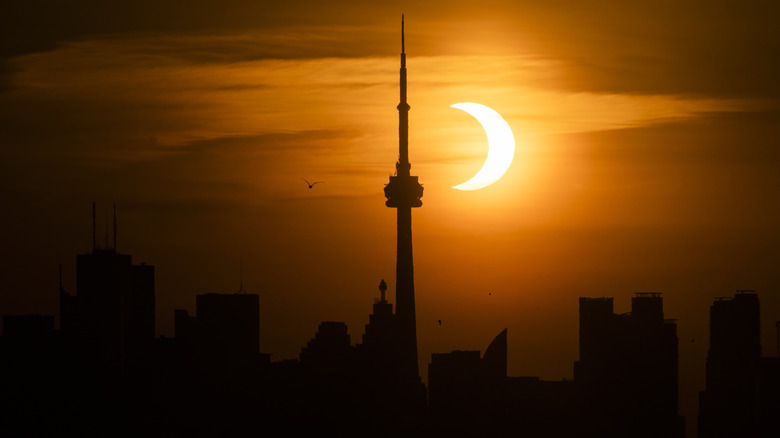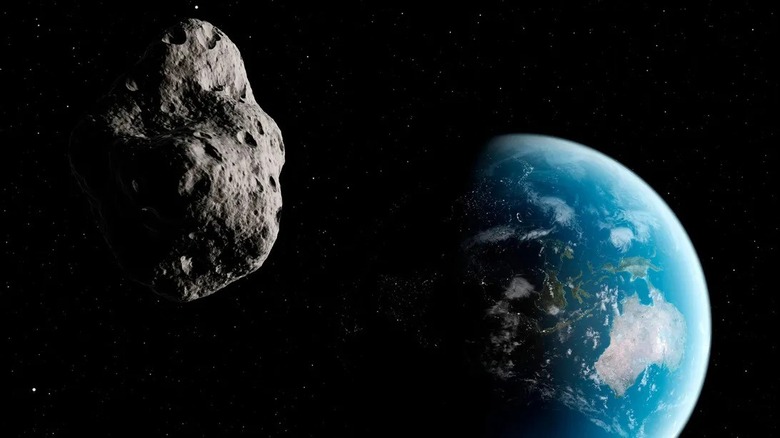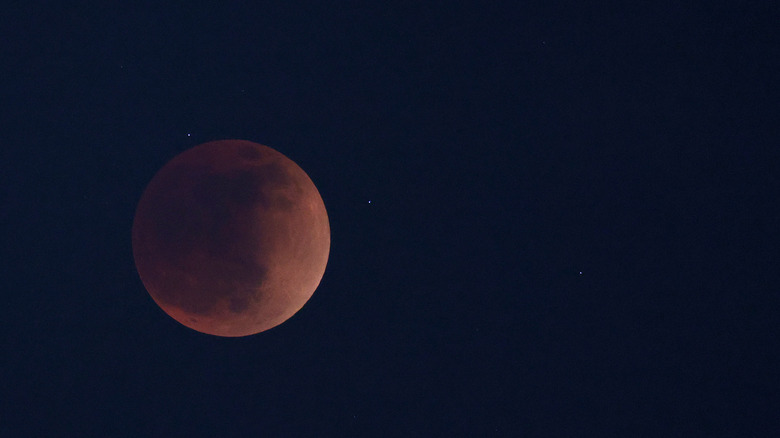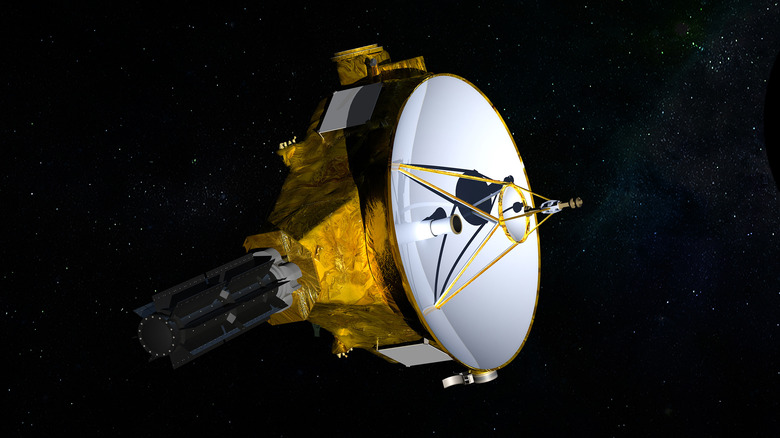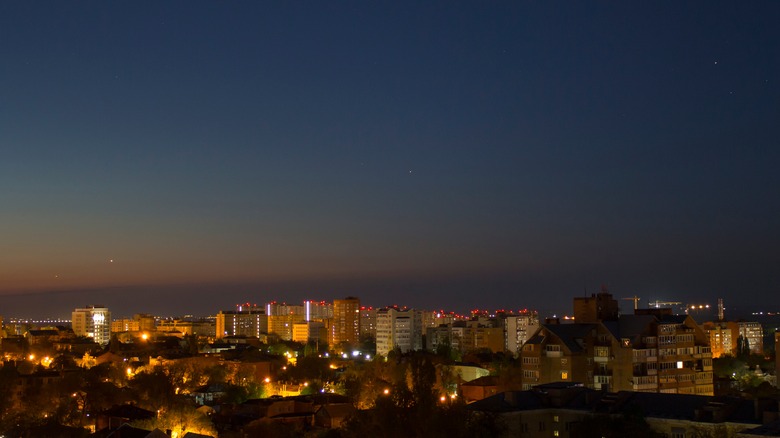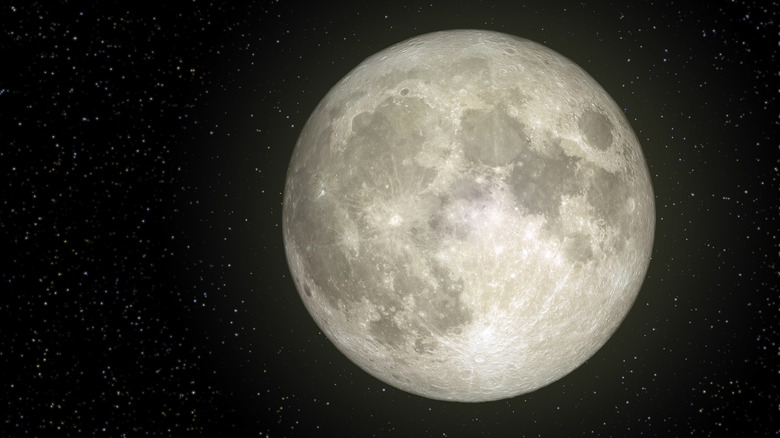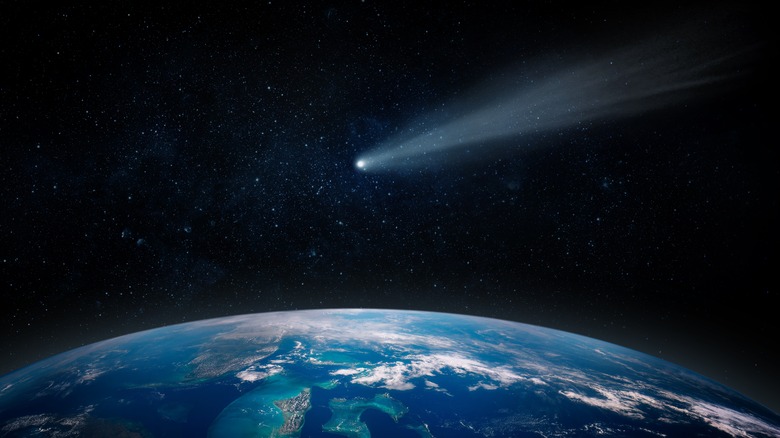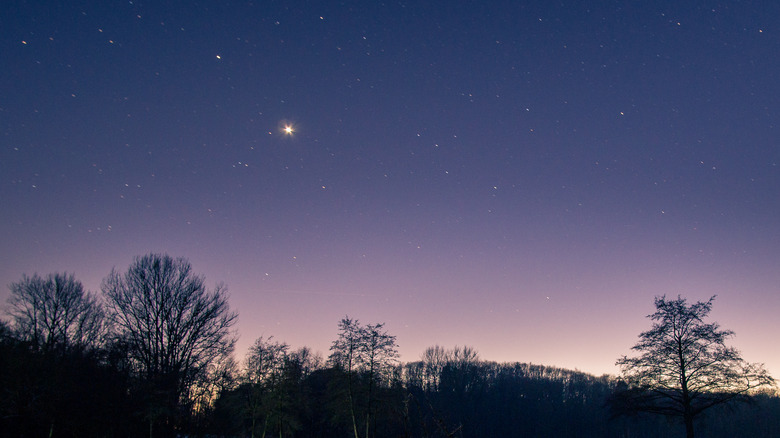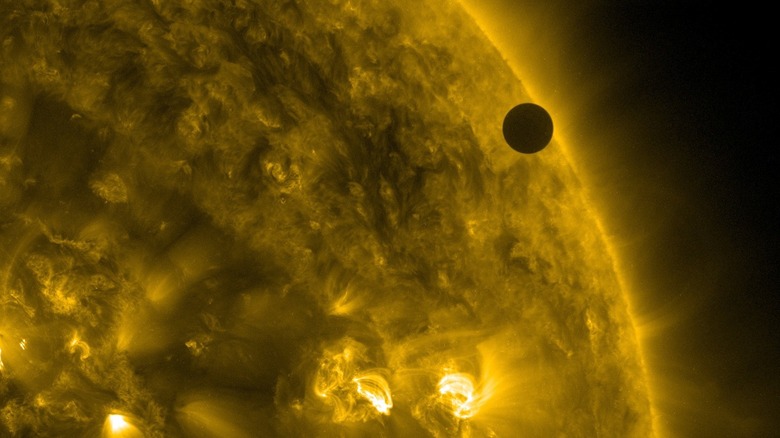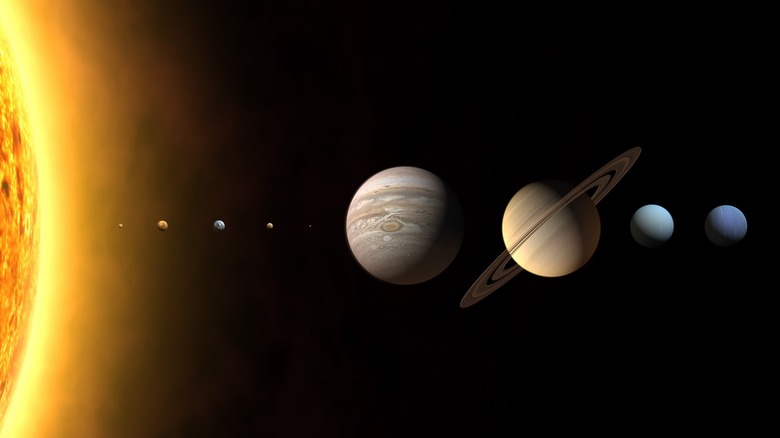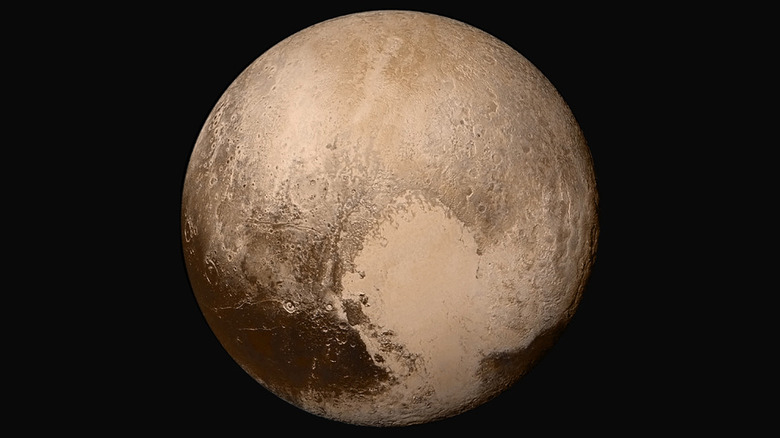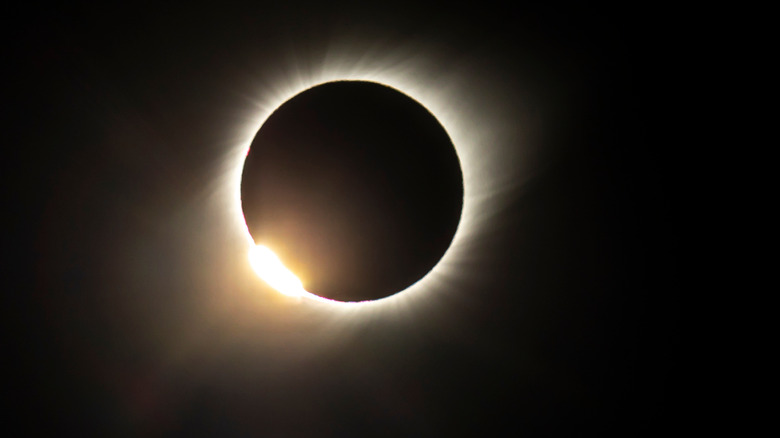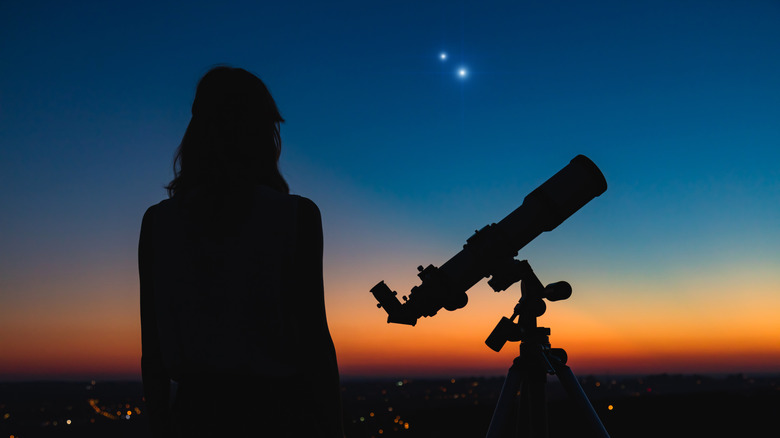Amazing Astronomical Events Happening In The Next 200 Years
The entire Universe is in constant motion, and much of it is as regular as the gears in a clock. The motions of planets and stars can be calculated using simple mathematics, allowing astronomers to accurately predict events in the night sky, sometimes centuries in advance. Each year contains an entire calendar of celestial events, like one maintained by In-The-Sky.org. Some of these are the reserve of dedicated stargazers with telescopes, while others are such prominent events that anyone interested can simply look to the sky to see them.
For thousands of years, as the University of Oregon explains, people have gazed upward and anticipated events like these. Stargazing has a history far older than modern astronomy; according to UNESCO, it has its roots in the older protoscience of astrology, and many of the terms still used, like conjunction and occultation, may be familiar to those interested in horoscopes. Astrologers were among the first to accurately predict the motions of planets through the sky, and their studies laid the groundwork for modern astronomers to follow. The same old principles are still used to predict cosmic events, and they're accurate enough to calculate things centuries before they happen. Often fascinating and sometimes spectacular, there are some rare treats in store for skywatchers over the next two centuries.
2029: Close encounter with asteroid Apophis
Our Solar System is absolutely littered with asteroids. Drifting hunks of space rock, some as small as boulders, others as large as mountains. And, as NASA has been carefully cataloging, a lot of them are disconcertingly close to Earth. In 2029, one is due to skim right by us. Asteroid 99942 Apophis, around 1,100 feet across, became infamous when it was discovered in 2004 and was labeled as one of the most hazardous objects orbiting the sun. The prospect of an asteroid hitting our planet is a terrifying one, but NASA has closely studied Apophis' orbit and calculated that Earth will be safe from it for at least a century. That said, while it won't hit us, it'll still pass uncomfortably close.
On April 13, 2029, according to EarthSky, Apophis will pass within just 19,662 miles of Earth's surface. That may not sound close, but, in astronomical terms, it's a startlingly near miss. As ESA notes, that's ten times closer than the moon, and closer even than geostationary satellites like the ones used for GPS. Remarkably, as NASA also mentions, it'll even be visible in the sky without a telescope! As Apophis swings past Earth, its orbit will be shifted by our planet's gravity, meaning it'll come back for another close pass in 2068. Scientists are confident, though, that an impact is also very unlikely on its second visit.
2029: The darkest lunar eclipse of the century
Lunar eclipses have been observed throughout human history, happening as the moon passes into Earth's shadow, as Space.com explains. As it does, the sunlight passing through Earth's atmosphere tints the moon's surface a deep red color, sometimes giving it the nickname of a blood moon. Earth's shadow has two parts. The partial outer shadow, called the penumbra, and the full shadow, known as the umbra. The most dramatic eclipses are total, as the moon passes through Earth's umbra, while shallower penumbral eclipses are much fainter, and can sometimes be difficult to even see. The closer to the center of the umbra the moon passes, the darker the eclipse, and in 2029, Earth will see one of the darkest eclipses possible.
June 26, 2029, will see the moon pass through the deepest part of Earth's shadow in a total eclipse. Immersed in Earth's umbra, the eclipse will last for 1 hour and 42 minutes (via NASA). The entire event, from the moment Earth's shadow first touches the moon to the moment it leaves, will last for a stunning 3 hours and 40 minutes, and according to NASA's almanacs, it'll be the darkest eclipse between 1951 and 2050. The best place to enjoy the view will be in South America, where the whole spectacle will be visible in the sky.
2040: New Horizons leaves the Solar System
This isn't an event anyone can see directly, but it's an accomplishment all the same. NASA's New Horizons spacecraft made history in 2015 when it flew past Pluto, sending back the first-ever images of the icy little world in the Solar System's outer reaches. As the University of Maine mentions, it's also the fastest spacecraft ever launched, and, after visiting Pluto, it's on a one-way trip to interstellar space.
The edge of the Solar System isn't well defined (there isn't exactly a fixed border there), but the Voyager space probes took measurements as they left and passed into interstellar space, which helps astronomers estimate where the edge lies. The boundary is seemingly around 125 times the distance from Earth to the sun, and New Horizons, according to Futurism, will reach that boundary sometime around 2040. After well over three decades of traveling through space, though, it's uncertain whether it'll still be operational when it gets there. After it exits the Solar System, leaving the sun's influence behind, New Horizons will be exposed to the harsh environment of the deep space between the stars. As this happens, it'll join a select handful of human-made objects to ever leave the Solar System – alongside Pioneers 10 and 11, and Voyagers 1 and 2 (via NASA).
2040: The planets line up in the sky
Planetary alignments happen when the planets appear to form a straight line in Earth's skies, as National Geographic explains. Events like these are sometimes known as conjunctions, a term that will be familiar to both astronomers and astrologers. While this doesn't mean the planets are physically lined up in their orbits, it can still make for a dramatic sight in the night sky. The planets, particularly Jupiter and Venus, shine brightly enough that they're visible even in the light-polluted skies of big cities. That said, by far the best view by far will be from darker rural skies, and a sight like a planetary alignment is worth traveling someplace dark to see.
On September 8, 2040, every planet visible to the naked eye will form an orderly queue, according to NASA. Mercury, Venus, Mars, Jupiter, and Saturn will line up together with the crescent moon in a cluster in the evening sky and will make for a striking view from almost anywhere on the planet.
2052: The brightest supermoon of the 21st century
The moon's orbit isn't perfectly circular. Instead, it orbits Earth in an ellipse, which makes its exact distance from our planet vary by around 47,000 miles every orbit. According to NASA, the closest point in its orbit is called perigee, and because of how the moon's orbit varies, some perigees are closer than others. All of this orbital variation may sound complex, but it's also quite straightforward to predict, and when a full moon happens at the same time as a perigee, you get a supermoon.
The term was first coined in 1979, and, as NPR explains, a supermoon can appear about 17% larger and 30% brighter in the sky than a regular full moon. Especially under darker skies, a supermoon really can be noticeably brighter than usual, and the closer to perigee the full moon, the brighter it will appear. It's rare for the two to perfectly coincide, but they'll come very close to doing so on December 6, 2052. As National Geographic reports, this will be the closest and brightest supermoon of the entire 21st century, with the moon being just 221,472 miles away from Earth – over 17 thousand miles closer than the moon's average distance (via Space.com).
2060: Close encounter with a comet
Comets are the dusty leftovers from the Solar System's formation eons ago, as NASA explains. And the outer reaches of the Solar System contain billions of them. Whenever they stray closer to the sun, they warm up and start to puff off gas and dust into space. The bright head of a comet can often be easily seen in Earth's skies, surrounded by a big glowing gas cloud that can reach the size of a planet. The solar wind also makes them stream off long glowing tails, which can make for a spectacular view. The closer they pass to Earth, the more impressive they can appear in the night sky.
On October 27, 2060, Earth is due for a close visit from a comet named 15P/Finlay, named for its discoverer. According to a paper in Monthly Notices of the Royal Astronomical Society, this comet was first reported in the late 19th century, and, unlike the ones in the Solar System's outer reaches, it has a relatively short orbit of just 6.6 years. When it passes by Earth in 2060, it will become one of the closest comets to approach Earth in the entire 21st century, at just over 4.6 million miles away. This may be the best-known comet to pass by Earth, but it won't be the closest. According to the University of Maryland, a more recently discovered comet (249P/LINEAR 53) will pass very slightly closer to Earth in 2076.
2083: A new brightest star in the sky
The orbits of planets aren't the only things in the night sky which can be predicted by astronomers. Many stars vary in brightness over time, some of them quite dramatically. The star V Sagittae is nothing special right now, barely visible even with a mid-sized telescope, but according to PhysOrg, around 2083, it's expected to become a nova. For a while, it'll be the brightest single object in the entire galaxy, outshining every other star in the night sky.
V Sagittae is actually not one star but two, in a binary system. It's a type of star called a cataclysmic variable which, as NASA explains, is a regular star being slowly devoured by a white dwarf. Slowly, the white dwarf strips off the star's atmosphere, stealing mass. Building it all up. Eventually, when it's accumulated enough, it'll cause a massive explosion, emitting an immense amount of light. A stellar explosion like this is called a nova, so-called because, to early astronomers, they seemed to suddenly appear as new stars in the sky (via Britannica). These aren't the same as their more famous big brothers, supernovae, however. While a supernova ends with the star being completely obliterated, a star can survive a regular nova to cause more explosions in the distant future.
2084: A rare view of Earth from Mars
One of the most exciting events to happen in the 21st century has never been seen by human eyes before. Seen from Mars, Earth will transit the sun, appearing as a silhouette against it. A planetary transit is when any planet appears to pass in front of its parent star. As NASA explains, astronomers look for transits happening around other stars to hunt for exoplanets, but they also happen closer to home. According to the Royal Astronomical Society, a prominent recent one in our Solar System was in 2012, when Venus transited the sun.
Impossible to see without the right equipment, a transit is a rare sight to behold, and, per Sky at Night Magazine, during a transit of Earth, both our planet and the moon will be clearly visible in silhouette against the surface of the sun. The last Earth transit seen from Mars was visible in 1984. Or at least, it would've been if anyone had been there to look. There's a chance that there may actually be humans standing on Mars on 10 November 2084, but even if there aren't, viewers on Earth may still have a chance to see the spectacle, thanks to robotic space probes. NASA's Perseverance rover has already witnessed a solar eclipse on Mars, as Science Alert reports, when the martian moon Phobos passed between the sun and Mars. Future rovers may easily be able to watch an Earth transit too.
2100: Polaris is closest to true North
Polaris is famous as the North Star, having been used for centuries to help sailors navigate, but it doesn't actually lie above Earth's true north. The axis of our planet isn't fixed but slowly moves over time in a process called orbital precession (via NASA Earth Observatory), making Polaris trace a glacially slow circle in the night sky. Precession essentially means that our entire planet is very slowly wobbling like a giant spinning top. As it does so, the positions of the stars gradually shift their positions in the sky, and the effect is most noticeable for stars over the poles.
According to EarthSky, the closest Polaris will ever come to being above Earth's true north will be on March 24, 2100. After this, Polaris will slowly drift away from true north and won't return again for 26,000 years! Centuries into the future, around the year 4000, Earth's axis will have shifted enough that Polaris will be replaced by a new North Star, Gamma Cephei, in the constellation of Cepheus.
2161: A lopsided Solar System
May 19, 2161, will see the unusual event of all of the Solar System's planets being on the same side of the sun, within 69° of each other. The last time this happened was in 1982, as reported in an old New York Times article. At the time, astronomers at Kitt Peak National Observatory made the prediction that the next time this happens will be in the middle of the 22nd century.
While every planet may be in the same part of the Solar System in 2161, they won't perfectly line up. The idea of every planet forming a perfectly straight line is a popular idea in science fiction and fantasy, and this would be a truly rare event. So rare that, as Sky and Telescope Magazine explains, the chances of it happening are quite literally astronomical. According to probability, such a perfect alignment of planets is only expected to occur once every 13.4 billion years. This is almost the age of the Universe itself, and much longer than the lifespan of the sun. What this means is that, while it may be a fun idea to think about, it's probably never going to happen. All on the same side, it seems, is the closest the planets are ever going to get.
2178: Pluto's anniversary
This event is not so much an astronomical event but a historical one. In 2178, Pluto will finally complete once full orbit since it was first discovered (via Live Science). Everyone's favorite dwarf planet was officially discovered on February 18, 1930, by Clyde Tombaugh at Arizona's Lowell Observatory. As NASA explains, it was named by an 11-year-old girl named Venetia Burney, who suggested the name of the mythical god of the underworld. Under her married name of Burney Phair, she later received a personal visit in 2006 from NASA's Dr. Alan Stern, the principal investigator of the New Horizons space probe, which was en route at the time, to visit the planet she'd named. Sadly though, she didn't live to see the photographs of it in 2015.
Similarly, it's likely that no one alive today will be able to celebrate Pluto's first anniversary in 2178. As Space.com mentions, Pluto's orbit is famous for two things. Being eccentric and taking a very long time. Orbiting in a stretched ellipse, the cold little world crosses inside the orbit of planet Neptune on its journey around the sun. It takes a colossal 248 Earth years to complete a single orbit. Since its discovery, it hasn't even traveled halfway!
2186: The longest solar eclipse in 10,000 years
Solar eclipses are among the most dramatic and awe-inspiring of astronomical events, and they only happen thanks to an impressive coincidence. As Britannica explains, it's purely by chance that the sun and moon appear the same size in Earth's sky. According to the University of Southern Maine, the moon is gradually moving away from Earth, and in the distant future total eclipses will no longer happen. Right now, though, a solar eclipse occurs whenever the moon passes in front of Earth, casting a shadow on its surface, and total eclipses happen whenever the moon is close enough for the dark umbra of its shadow to reach Earth.
July 18, 2186, will be a date for our descendants to mark in their calendars. NASA keeps a ten-millennium catalog which, as its name implies, contains 10,000 years of eclipses calculated in detail. The eclipse of 2186 will have the longest duration of the entire lot. Viewers on Earth will be able to watch a solar eclipse lasting for 7 minutes and 29 seconds. This is remarkably close to the theoretical maximum possible duration for an eclipse, of 7 minutes 31 seconds (via the U.K. Hydrographic Office). Eclipse Wise shows that the best place to see the 2186 solar eclipse will be in South America. Thankfully though, with over a century and a half to go, there's no rush to start making travel plans.
2223: Mars occults Jupiter
Occultations are when one object passes in front of another, completely blocking its light. Technically speaking, a solar eclipse is a type of occultation, albeit a very large and spectacular type. But the same thing happens less noticeably as planets or stars have their light blocked by other planets, or even by asteroids. As Space.com explains, occultations involving other planets have long been used by astronomers to learn things about their atmospheres or planetary rings. The rings of Uranus were first observed during an occultation, and another allowed astronomers to study the atmosphere of Pluto long before New Horizons arrived there.
Seen from Earth, according to physicist Larry Bogan, the rarest occultations by far involve the planets outside Earth's orbit, with some not occurring even once in several millennia. One such rare occultation is due to happen on December 2, 2223, as Mars passes in front of Jupiter for the first time in 836 years. This rare event will need a telescope to get the best view. Fortunately, occultations like this one are quite easy to view with a good telescope, and, in two centuries, amateur astronomers are likely to be enjoying a glimpse of this fleeting once-in-a-lifetime event.
